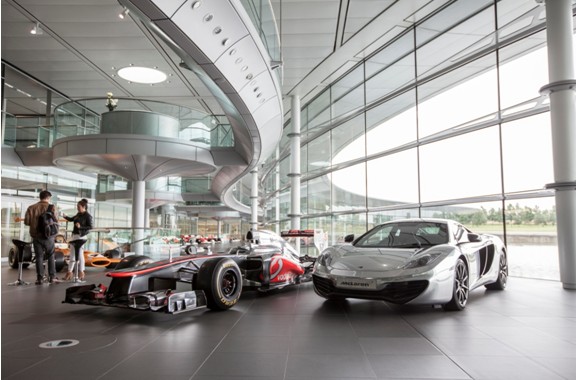Having been a fan of the scarlet red Ferrari cars and a certain Schumacher since I was a small boy, McLaren in some ways was the bad guy of my childhood. Driver Mika Hakkinen was the Dick Dastardly who stole those Championships from my German hero, and Ron Dennis was the evil mastermind who sat smugly in his oversized office chair as his silver cars challenged the prancing black horse. But these are nothing more than my innocent childhood memories of course, so now as a young adult I’ve dispensed with the cartoon references and thankfully have a far greater understanding of the very serious challenges a Formula 1 team faces. Naturally then, McLaren, an F1 team with a higher win-to-race ratio than even my mighty Ferrari, is a team I have much respect for. So you can imagine how excited I was as I was driven up to the doors of the McLaren Technology Centre (MTC) and walked through its futuristic entrance. My expectations were high, but even I had not anticipated the warmth of the McLaren welcome that awaited me on that exciting day.
To describe what we walked into as 'a reception' would almost be an insult. Yes, there was a desk, but just behind that sat a proud display of McLaren’s illustrious history, with some 50 years of the team's thoroughbred racers sitting side by side along the meticulously polished floor of the glass fronted walkway. Both classic and modern McLaren Formula 1 and Can-Am cars sat looking as though they could fire into life and race off at any moment. And we were fortunate to have a few minutes to enjoy some brownies as we ogled the stunning machinery. Amazing - who knew McLaren makes better brownies than Tesco?
The motor racing pedigree shown in McLaren’s display of historic engineering was something I had expected. This was a team I had followed through Formula 1 all my life, of course. But as we were led into a glass walled meeting room, with a McLaren MP4-12C Spider on a rotating platform to welcome us, the company’s Brand Director, John Allert, did a pretty good job of explaining how McLaren are very much more than just a racing team.
For starters, he barely talked about F1. He mentioned a brief history of McLaren Racing, pointing out that the brand is centred around motorsport, but he seemed fairly happy to skim over the phenomenal Senna-Prost years, and the life-risking Hunt battles of the 1970s. Instead, Allert focused on talking about McLaren Group, the collection of 5 McLaren companies that are housed in the MTC. McLaren Racing makes up a large percentage of the group, with 650 of the 2200 staff assigned to the Formula 1 operation, but Allert emphasised that the other 1550 employees were working equally as hard in entirely different fields, in order to meet deadlines for a to-do list as impressive as the award winning Technology Centre itself.
With the 12C supercar rotating behind me, it was hardly surprising that Allert should explain how McLaren Automotive, the road car division of the group, is of significant interest to him at the moment. This is a company that once produced only small-volume cars such as the iconic F1 and the Mercedes partnered SLR, but they are now stepping bravely into the world of road vehicle production as a long term venture. Even with their wealth of racing experience however, one can’t help but think that breaking into this fiercely competitive industry poses a significant challenge to McLaren. Their 50 years of racing knowledge will certainly help, but competing with established names such as Ferrari and Porsche requires much more than technical expertise. Allert seemed aware of this, as he explained how real success for McLaren as a supercar manufacturer means that school children across the world will have to list it as one of their ideal cars, much as they do now with Lamborghini, Ferrari and Porsche. McLaren will have to become a dream brand, one of the poster boys of the automotive world.
This was my first surprise. How could a brand concerned with things like ensuring their technology centre floor shines like a mirror compete for market share with brands like Ferrari, whose employees probably care more about the quality of pasta served across the road? Surely McLaren Automotive would have to ditch the Racing division’s finicky attention to detail to compete with that ‘bad boy’ image of Lamborghini? Well according to Allert, that is not the case at all. He explained that McLaren could enter the luxury brand battle in its own way, by building a car that is “quantifiably the best”. His theory is that if McLaren build the lightest, fastest and all round highest performing supercar, it will become the car that the elite aspire to own. And you know what - I really started to believe in his confidence. Not least because the MP4-12C beats its main rival, the Ferrari 458 Italia, hands-down in terms of performance. With a 0-60 time 2 tenths quicker than the Ferrari’s languid 3.3 seconds, and a top speed 5 mph higher than the Ferrari’s measly 202 mph, as well as a starting price that undercuts the Ferrari by ?1000 at ?168,000, the McLaren’s numbers are best in class. And if I’m honest, the 12C rotating behind me was becoming ever more desirable as its purposeful shape hinted at its outstanding performance.
But the fun doesn’t stop there. McLaren Automotive is now also producing its first hybrid hyper car, the P1, with F1 derived KERS technology that in quantitative terms will at very least match its main rival, the LaFerrari hybrid hyper car. Both will accelerate to 60mph in under 3 seconds, and both will achieve a top speed well over 200mph. But Allert believes that with its ability to run entirely on electric power, McLaren’s monster will be the more environmentally friendly vehicle, and with the use of an F1 style DRS rear wing and boost button it will be more driver-friendly as well. In McLaren’s eyes at least, the P1 is the class leader and therefore the top dog.
Whatever the ultimate result of this top-of-the-bill punch up, you can’t deny that McLaren Automotive are going about things in their own innovative way. This is a trend that seems to trickle down throughout the McLaren Group operation, as it is apparent that innovation is at the forefront of everything McLaren does. Headed by the F1 division, Allert explained that McLaren’s talented boffins create an innovation every 8-10 minutes. That’s means that an average of 6 new ideas for its racing car every hour. That’s a lot of technological breakthroughs and potential giant leaps forward in a cycle of just 60 minutes. This is where Allert confidently believes there is huge potential for McLaren’s ideas to be utilised in industries that are seemingly unrelated to Motorsport.
The healthcare industry for example, has no need for fast-paced development of aerodynamic parts or high performance engines. But much like world class motorsport, healthcare does require the evaluation of human physical fitness. In this context, it seems less surprising to learn that McLaren’s Advanced Technologies division (MAT) is investing heavily in utilising technology derived from F1 in the diagnosis of potential health problems and diseases. Geoff McGrath, the division’s Managing Director, spoke very passionately about MAT’s fantastic achievements as well as its exciting future. Healthcare is certainly one of the most interesting areas of investment for MAT, with the company already helping to develop and improve sensors to determine the condition of patients. Much like sensors are able to monitor an F1 car’s temperatures and pressures, these sensors can evaluate the performance of a patient’s heart during exercise, or even analyze the condition of organs with real-time data. But it doesn’t stop there - McGrath wants MAT to be a real game-changer, and to do this he has his eyes firmly set on the future.
How does Bio Enhancement sound to you? Well MAT is in the early stages of developing technology that could one day help to improve human beings. By understanding the real-time performance of a human body, it can be possible to find ways to improve the owner's general fitness and health. This might sound like the plot of a Sci-Fi film, but it is a very real development that MAT hopes to bring to the world of science and health. Just think - one day we could be benefiting from McLaren-derived sensors to forecast upcoming health issues, or even to improve our very own health.
Health improvements are a future development, but boosting athletic sporting performance is something MAT can do right now. McGrath explained that MAT was partly responsible for a great deal of success in sporting events across the world, including the GB Olympic Bobsleigh team’s gold medal. This success was down to MAT’s ability to utilise sensors to provide real-time data for every bobsleigh run, which could enable the athletes not only to understand what they were doing, but also to work out how to improve their techniques. With the precision and accuracy of F1 derived sensors, the athletes were able to strive for absolute perfection, and as a result they won the gold at London 2012. The same success was experienced by cyclist Mark Cavendish, as he rode his MAT designed carbon fibre Venge bicycle to win stages at the Tour De France in 2011, 2012 and 2013. Using F1-style carbon fibre technology and wind tunnel equipment, Cavendish’s bicycle was not only lighter, but also better adapted aerodynamically to his build. So in many ways, MAT are already 'game-changers', suggesting that the future prospects of this McLaren division are very exciting indeed.
The same could be said about the entire McLaren Group, as my eye-opening visit to its Technology Centre showed. Who knew that an organisation I once associated only with the construction of racing cars was in fact involved in such a wide range of industries? McLaren is able to bring innovation from its Racing division, and push it into relevant areas of some wholly different sectors. Even more impressive is the fact that my visit probably covered only about 10% of the building. A number of closed doors and hidden passages could lead to rooms where the next generation of technology is being developed, in areas and industries far from McLaren’s racing roots. So what initially seemed to me to be a very functional, almost cold racing team, turned out in fact to be a life-saving, performance-enhancing pool of talent with a real sense of innovation. My childhood resentments couldn’t have been further from the truth - McLaren is nothing like Dick Dastardly after all.
 |

 分享到人人
分享到人人 分享到QQ空间
分享到QQ空间

 恭喜你,发表成功!
恭喜你,发表成功!

 !
!











